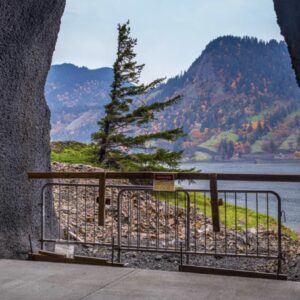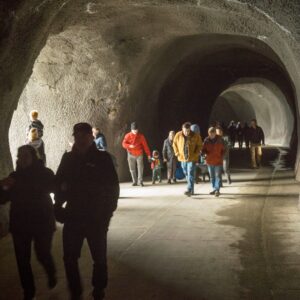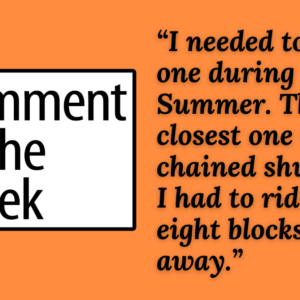
On Wednesday I shared a look at what PBOT plans to do on NE Multnomah as part of a project to re-configure that key east-west connector through the Lloyd District. NE Multnomah is poised for major residential and retail development, and this project is a golden opportunity to transform what is now a sleepy, old-school urban arterial with too much auto-capacity into a street where people feel comfortable bicycling, walking, shopping, and living.
Since this project has been developed outside the purview of citizen activists, PBOT’s Bicycle Advisory Committee (one of whom’s members said they were “bulldozed” by this process), and bike advocacy groups — other than the open house on Tuesday, there has not been any opportunity for the public to weigh in.
This project was designed by an invite-only “task force” (members listed below) of private business owners, real estate developers, and local agency representatives — several of whom opposed the NE Holladay project (which was the catalyst of the Multnomah project) because they didn’t want to lose any on-street auto parking and/or they wanted to maintain all existing auto capacity.
Task force member Irene Bowers with the Portland Development Commission (PDC) said she couldn’t support a proposal on Holladay because, “As the representative of economic development agency of the City, I can’t support taking parking off [the street].”
During a meeting for the Holladay project, Bowers came to the defense of David Gragg, the Senior Parking Manager for commercial real estate firm Ashforth Pacific and Chairman of the Lloyd Transportation Management Association (TMA), who was concerned about losing auto parking because his company was trying to sell buildings in the area and fewer parking spaces would mean lower building values. Gragg said, “As we start making these decisions [about parking], we start affecting long term plans for the short term benefit of a carefree bicycle ride for 14 blocks.”
Wade Lange, a former Ashforth Pacific VP, was the sole “no” vote on the Holladay project and he convinced PBOT to switch their attention to Multnomah.
It’s worth noting that NE Multnomah currently has zero on-street auto parking, and the proposed plan would add around 70 new on-street spaces (while adding no bike parking, at least initially).
PBOT is ready to go with this project. They have the funding in place, and from their comments at the open house, they would like to get it built and in place this summer. There is not a formal public process, nor are their more open houses planned. The only way to weigh in is by sending your comments to project staff via email.
Just yesterday, the City of Portland posted the design proposals online and posted a website for the project.
If you have input about this project you would like to share with PBOT, please email multnomah.mainstreet@portlandoregon.gov.
— For background, please see the NE Multnomah St Project story archives.
——
Here is the list of people that were on the task force:
-
Alan Huston – Lloyd TMA Pedestrian Committee/DoubleTree
Craig Harlow — Lloyd TMA Bicycle Committee
Wanda Rosenbarger — Lloyd Center/Glimcher
Justin Zeulner — Rose Quarter
Wade Lange — Langley Investment/ American Assets
Mick O’Connell — Schlesinger Companies
John Sullivan — Kaiser Permanente
Shannon Mayorga — Kaiser Permanente
Rick Kuehn — Lloyd TMA/CH2MHill
Terry Goldman — DoubleTree Hotel
Irene Bowers — PDC
Dan Marchand — TriMet
Young Park — TriMet
Sarah Heinicke — Lloyd EcoDistrict
Karen Totaro — Oregon Convention Center
Jerry Becker — Legacy Health
Kip Wadden — City of Portland ‐ Parks & Rec.
Sue Glenn — City of Portland ‐ Parks & Rec.
Tom Miller — City of Portland ‐ PBOT
Ellen Vanderslice — City of Portland ‐ PBOT
Rob Burchfield — City of Portland ‐ PBOT
Dan Layden — City of Portland ‐ PBOT
Wendy Cawley — City of Portland ‐ PBOT
Mauricio LeClerc — City of Portland ‐ PBOT





Thanks for reading.
BikePortland has served this community with independent community journalism since 2005. We rely on subscriptions from readers like you to survive. Your financial support is vital in keeping this valuable resource alive and well.
Please subscribe today to strengthen and expand our work.
“Gragg said, ‘As we start making these decisions [about parking], we start affecting long term plans for the short term benefit of a carefree bicycle ride'”
I think what he meant was “As we start making these decisions [about parking], we start affecting short term economic gains for the long term benefit of a car-free bicycle ride”
“Short-term carefree bicycle ride?”
Tell that to people 10 years from now riding on the Sullivan’s Gulch Trail.
As someone who bikes Holladay St 500 times per year (twice daily), I’m mighty disappointed that the Holladay Plan has been scrapped, leaving me (and many others) no alternative but to continue buzzing Convention Center pedestrians on the sidewalk (carefully and respectfully, of course) when riding eastbound every day. I’ll never ride a busy street like Multnomah. Never. With nearly 100,000 miles of bike cummuting under my belt, I’ll always seek out the quieter streets whenever possible.
oops, i’m directionally dyslexic. I meant westbound, not eastbound, on the Holladay Street sidewalk.
The more I think about this the more nervous it makes me. They suggest all the street-enhancements and cycle tracks will be added in a later phase. But temporarily they will just add in a bunch of new parking.
We saw on NE Holladay how hard it was to remove parking. Why does PBOT think that these parking spots will be any different? By caving to powerful interest groups over and over they are committing themselves to keep the parking long-term. All those cute parklets in the proposals will not happen.
Before we make the spots real we should consider the politics around those spots. Is it smart to add more parking just to increase the real estate values? Are more parking spots actually needed (it seems like 70% of that area is already parking)? Sadly it seems no one at PBOT will stand up for a changing paradigm.
This is planning gone wrong.
” Is it smart to add more parking just to increase the real estate values?”
It’s smart if you are one of the private business owners or property developers that gets to make decisions on behalf of Portland citizens in private closed door meetings.
Nowhere on the corridor has parking on both sides. If you just narrow the width of the bike protection buffer on the non-parking side (the plans show an 8′ width), you could give that space to the side with parking and create a parking-protected bike lane. This would make a curbside, almost-entirely protected lane along the entire corridor. Yes, it would cost a few more parking spaces (for mixing zones) and the driving lanes might be slightly offset, but I think it would be a much simpler plan, where everyone is happier.
Except the property owners who want parking on their side of the street…
Who don’t have parking currently… so what grounds do they have to complain?
Like I keep saying; have a week where all cyclists drive to work and errands . . . borrow a car if you have to . . . that would really make these fools stop and think. The number of people who cycle to work in that district ALREADY displaces/saves a boatload of parking.
DRIVE TO WORK DAY, anyone? We can send a message that it should be driving to work that is a special event you do once a year rather than walking, cycling or taking transit. We can give out free car tuneups too.
Here’s what I wrote. Feel free to modify, sign and email it to multnomah.mainstreet@portlandoregon.gov:
“We were disappointed when the Holladay plans were shelved, but hoped this road diet woudl help. But I am now really disappointing about the current plan, because it could be an excellent improvement with just a few changes.
The planned design, with parking usually to the left of narrow bike lanes, is worse for bikes and will put bikes in conflict with people parking who need to open doors, leading to dangerous situations and likely injuries from “dooring”.
The parking should be to the LEFT of the bike lanes, the whole way.
Basically, the existing 5 foot bike lanes should remain in place, a 3 foot buffer would be added to the left (to prevent conflicts between people exiting parked cars), and then 7 feet for car parking, plus bike corrals, landscaping and pedestrian refuges, would go to the left of that. This leaves the central 3 lanes the same, and generally should fit in with the current plans. And now bikes will be out of the door zone and away from cars, while the business owners get the on-street parking that they want.
I see no disadvantages to this configuration. It has already been proven to work in Portland on SE Broadway and NE Cully, as well as in many other cities.
Task force committee members: please cite evidence that more parking increases property values. I just can’t take your word for it. Currently, it looks like the property values in the district are being held down by excess parking capacity. There are way more spaces in Lloyd District than in downtown, yet property values are higher downtown.
It’s not a theory peejay. It’s just a basic real estate thing. Each individual parking space that is guaranteed with a building ups the value of that building by a set amount.
The real estate community may set prices, but the market determines actual prices. This neighborhood is moribund in no small part because of the excess of parking, which makes the streets not feel inviting, and diminish pedestrian activity, thereby cutting value to retail and dining establishments. The place is a ghost town. Its property values are less than so-called “parking deprived places like NW 23rd, Mississippi, and downtown.
I think the distinction is this: Parking spaces in front of commercial real estate increase the value on sale of the property.
But there is no proof it actually helps the business. (In fact in the Lloyd much of the street parking empties out after work, so it suggests the parking serve the office workers more than retail.)
Actually, if you think about it, it’s nearly impossible to operate a sidewalk storefront without on-street parking. Every vibrant main street in Portland has on-street parking. This is also true in most every first-world city on the planet. On-street parking is therefore critical to a walkable district. Balancing walkability and bikeability is important.
That said, I wonder why they are not doing the parking with a cycle track.
snow job all the way.
Could parking meter revenues be a factor influencing the parking decision?
If the city is really committed to getting the “interested but concerned” biking then Holladay not Multnomah should be the project. This is highly disheartening because one ‘no’ vote (from a an out of town company rep no less) sends PBOT back to doing a far less comfortable and safe design because it is easy both politically and design wise. This does not bode well for future efforts and designs that will attract more riders. With the limited funds available we need to spend the money wisely, that means sometimes spending a little more ($ and political capital) to get something in place that serves/attracts the broad range of bicyclists (and could attractive to tourists). This is in an area that receives a lot of out of town drivers for convention center, rose garden events and the mall. I ride Holladay because I don’t want to mix with those types of drivers on Multnomah. It’s about SAFETY. The current design would not be easily understood by out of town drivers, and makes bicyclist weave back and forth, resulting in a path &visibility that would be unpredictable to motorists. Step up and stick with Holladay folks, the low traffic, low speed, comfortable route that will keep cyclist safer and attract a wider range of cyclists.
The thing that makes my blood boil,is that they act like bike activists only want the bike infrastructure so we can have carefree bike rides. They always try to deflect the safety aspects of it. People want bike infrastructure so we don’t get hit, doored, run off the road, or run on to the streetcar/max tracks by careless drivers. It shouldn’t be unreasonable for a city to put safety of it’s citizens above property values.
My input has been sent to the Multnomah Streetscape team! Thanks for posting this, Jonathan!
I just emailed my comments to multnomah.mainstreet@portlandoregon.gov and to project manager Ross Swanson.
I really wish the Mayor would weigh in on this. Does he want this project, in it’s current state, to be part of his legacy?
I love that the bike infrastructure gets built later; Yet another chance for the Oregonian to harp on how much cyclists are costing the city with their “special” demands.
I spoke with PBOT, who implied that they thought parking protected bike lanes were possible, but that the real estate interests did not want people to have to cross a bike lane to get from their car to the curb. Wow. Parkers can walk across a bike lane in NYC, Copenhagen, and Long Beach, but not Portland? There’s really nothing quite like a bike lane designed by real estate developers.
“real estate interests did not want people to have to cross a bike lane to get from their car to the curb.”
Apparently the least amount of exercise possible is one of their aims. ; )
Might I sugest an increase in the taxes for businesses that get on-street parking on their frontage, by say a couple thousand dollars a year, more if the parking is unmetered?
I recently realized I have no particular desire to ever bike to work again since my route is west on Multnomah to get to work. I refuse to bike on the sidewalk, so Holliday is out, and I hate the fight on Multnomah with buses, parking lots, and crossing two lanes of traffic on a curving downhill to make a left into the Rose Quarter transit center. This plan does not appear to fix these issues any time soon. Such a bummer since Holliday would have been pretty nice! (of course, my solution is to walk to work, so I suppose it’s not the end of the world for me)